Solutions of The Human Eyes And The Colorful Wor (Page No- 288) - Physics By Lakhmir Singh, Class 10 | Extra Documents, Videos & Tests for Class 10 PDF Download
Lakhmir Singh Physics Class 10 Solutions Page No:288
Question 1: As light rays pass from air into a glass prism, are they refracted towards or away from the normal ?
Solution : Towards the normal
Question 2: As light rays emerge from a glass prism into air, are they refracted towards or away from the normal ?
Solution : Away from the normal
Question 3: Name a natural phenomenon which is caused by the dispersion of sunlight in the sky.
Solution : Rainbow
Question 4: What information do we get about sunlight from the formation of a rainbow ?
Solution : Sunlight consists of seven colours.
Question 5: What did Newton demonstrate by his experiments with the prism ?
Solution : Newton demonstrated by his experiments with the prisms that white light consists of a mixture of seven colours.
Question 6: What colours make up white light ?
Solution : Seven colours – Violet, indigo, blue, green, yellow, orange, red
Question 7: Give the meaning of the term VIBGYOR. With which phenomenon is it connected ?
Solution : The seven colours of the spectrum of white light are denited by the word VIBGYOR where V stands for Violet, I for Indigo, B for Blue, G for Green, Y for Yellow, O for Orange and R for Red.
It is connected with the phenomenon of dispersion of light.
Question 8: In the formation of spectrum of white light by a prism :
- which colour is deviated least ?
- which colour is deviated most ?
Solution :
- Red
- Violet
Question 9: What colours lie on the two sides of the ‘green colour’ in the spectrum of white light ?
Solution : Yellow and Blue
Question 10: Name the scientist who discovered that sunlight consists of seven colours.
Solution : Newton
Question 11: What is the order of colours in a rainbow, from the outside to the inside ?
Solution : Red, Orange, Yellow, Green, Blue, Indigo and Violet
Question 12: Which colour of the spectrum has (a) longest wavelength, and (b) shortest wavelength ?
Solution : (a) Red
(b) Violet
Question 13: Which light has the longer wavelength : red light or blue light ?
Solution : Red Light
Question 14: Which colour of light has the shorter wavelength – red or violet ?
Solution : Violet
Question 15: Fill in the blanks with suitable words :
(a) When a ray of light enters a prism, it bends…………. ..the normal; as it leaves the prism, it bends…………..
the normal.
(b) White light is composed of…………I The colour of white light deviated through the largest angle by
a prism is………..
Solution : (a) towards, away from
(b) seven, violet
Question 16:
- A ray of white light breaks up into its components while passing through a glass prism.
Draw a ray diagram to show the path of rays. - Mark the least deviated colour in your diagram.
- Why do different coloured rays deviate differently in a prism ?
Solution :
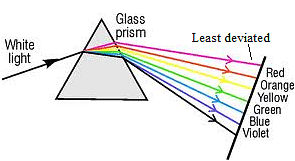
3. Different coloured rays deviate differently in a prism because different colours travel at different speeds through the glass prism.
Question 17: (a) What happens when a ray of ordinary light is passed through a triangular glass prism ?
(b) What will happen if another similar glass prism is placed upside down behind the first prism ?
Solution : (a) When a ray of ordinary light is passed through a triangular glass prism, it splits to form a band of seven colours.
(b) If another similar glass prism is placed upside down behind the first prism, then the seven coloured rays from the first prism which are incident on the second prism recombine to form the original white beam.
Question 18: When a beam of white light is passed through a prism, it splits to form lights of seven colours. Is it possible to recombine the lights of seven colours to obtain the white light again ?
Solution : Yes, it is possible to recombine the lights of seven colours to obtain the white light again by placing another similar prism alongside the first one in the inverted position as shown below.
The first prism disperses the white light into seven coloured rays. the second prism receives all the seven coloured rays from the first prism and recombines them into original white light. This is because the refration produced by the second prism is equal and opposite to that produced by the first prism.
Question 19: (a) What is spectrum ? What is the name of glass shape used to produce a spectrum ?
(b) How many colours are there in a full spectrum of white light ? Write the various colours of spectrum in the order, starting with red.
Solution : (a) The band of seven colours formed on a white screen, when a beam of white light is passed through a glass prism is called spectrum of white light. A glass prism is used to produce a spectrum.
(b) There are seven colours in the spectrum of white light. The colours are Red, Orange, Yellow, Green, Blue, Indigo and Violet.
Question 20: What is meant by dispersion of white light ? Describe the formation of rainbow in the sky with the help of a diagram.
Solution : The splitting up of white light into seven colours on passing through a transparent medium like a glass prism is called dispersion of light.
Formation of rainbow:

The raindrops act like small prisms. When sunlight enters and leaves these raindrops, the various coloured rays in white light are refracted by different amounts due to which an arc of seven colours called rainbow is formed.
Question 21: In the figure given alongside, a narrow beam of white light is shown to pass through a triangular glass prism. After passing through the prism, it produces a spectrum YX on the screen.
(a) State the colour seen (i) at X, and (ii) at Y.
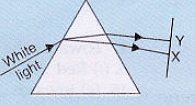
(b) Why do different colours of white light bend through different angles with respect to the incident beam of light ?
Solution : (a) (i) violet (ii) Red
(b) Different colours of white light bend through different angles because different colours travel through different speeds through in the glass prism.
Question 22: Draw a diagram to show how white light can be dispersed into a spectrum by using a glass prism. Mark the various colours of the spectrum.
Solution :

Question 23: Make two diagrams to explain refraction and dispersion.
Solution :
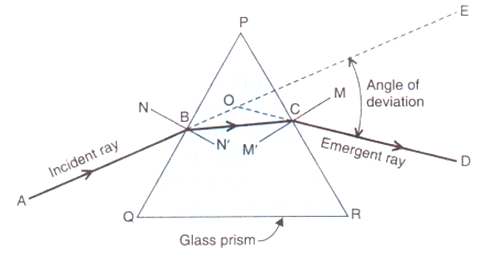

Question 23: Make two diagrams to explain refraction and dispersion.
Solution :
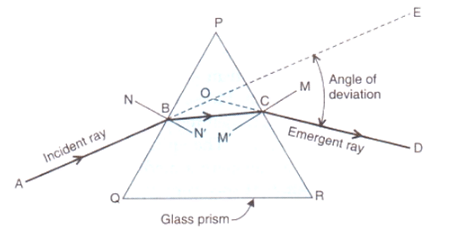

Question 24: Describe how you could demonstrate that white light is composed of a number of colours.
Solution : We will allow a beam of white light to pass through a glass prism. The white light splits to form a band of seven colours. This shows that white light is composed of seven colours.
Question 25: How could you show that the colours of the spectrum combine to give white light ?
Solution : Colours of a spectrum from one prism are allowed to fall on a similar prism placed adjacent to the first prism, but in inverted position. The refraction produced by second prism is equal and opposite to that produced by the first prism. This makes the colours of the spectrum combine to give white light.
Question 26: Which is refracted most by a prism : red light or violet light ? Explain why ?
Solution : Violet light is refracted the most because violet colour has the minimum speed in glass prism.
Question 27: (a)Draw a diagram to show the refraction of light through a glass prism. On this diagram, mark
- incident ray
- emergent ray, and
- angle of deviation.
(b) What is a rainbow ? What are the two conditions necessary for the formation of a rainbow in the sky ?
(c) What acts as tiny prisms in the formation of a rainbow ?
(d) Name the process which is involved in the formation of a rainbow.
(e) What are the seven colours seen in a rainbow ?
Solution :
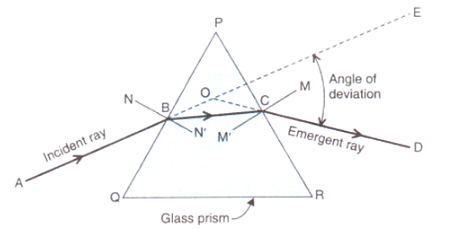
(b) Rainbow is an arch of seven colours visible in the sky which is produced by the dispersion of sun’s light by raindrops in the atmosphere. A rainbow is formed in the sky when the sun is shining and it is raining at the same time.
(c) Raindrops
(d) Dispersion of light
(e) Red, Orange, Yellow, Green, Blue, Indigo and Violet.
|
5 videos|292 docs|59 tests
|
FAQs on Solutions of The Human Eyes And The Colorful Wor (Page No- 288) - Physics By Lakhmir Singh, Class 10 - Extra Documents, Videos & Tests for Class 10
| 1. What are the different parts of the human eye and their functions? |  |
| 2. How does the human eye perceive different colors? |  |
| 3. What is the role of the lens in the human eye? |  |
| 4. How does the optic nerve transmit visual information to the brain? |  |
| 5. Are all humans' eyes the same? |  |
|
5 videos|292 docs|59 tests
|

|
Explore Courses for Class 10 exam
|

|

















